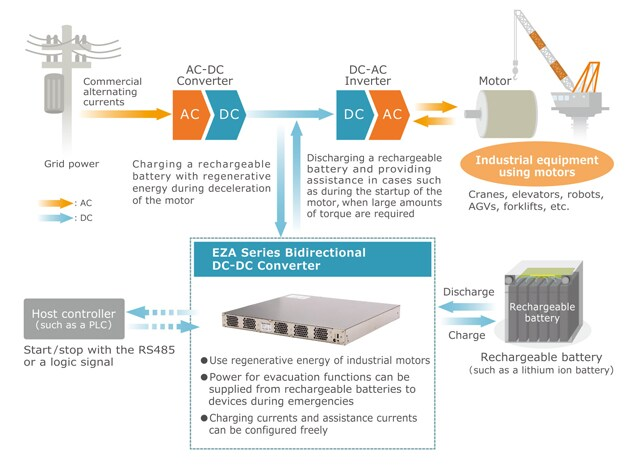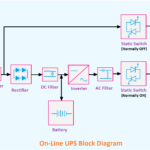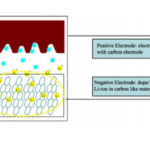Bidirectional power supplies dynamically direct power from multiple sources to different loads, some of which are also power sources at other times.
In recent years, there’s has been a dramatic increase in the need for bidirectional AC/DC and DC/DC power supplies, in addition to the unidirectional supply of a traditional UPS. That supply takes a source (such as the AC line or battery, or in some cases, a high-voltage DC line) and converts and regulates it to provide a DC-rail output for a load. In contrast, the bidirectional supply has multiple independent power sources. It can transfer energy from one to another as needed or available, as well as to the system’s primary load itself.
Bidirectionality with two power sources is not the same as simply having two independent power sources in parallel for higher capacity or in a redundancy arrangement where either can supply the system load. Instead, it involves continuous management of power flow from one source to the other as determined by the availability and load conditions. The load on each source may be independent of the other source’s load.
In contrast to a basic offline or online UPS, modern power subsystems and their applications must encompass a multiplicity of power sources and loads. Some of these will be a source at one time and load at another time depending on shifting of power availability and needs.
The objective is to take power from where it is available at any given time (such as from high-voltage AC or DC lines or solar panels) and send it to a primary load. If excess power is available, it can also go to storage (a battery, in most cases) for later use, but also be able to draw on the battery if the primary source is unavailable. (Figure 1).

Note that the local power user (the local load) can be an individual residence, neighborhood, commercial office building, or even a medical/industrial setting. Some excess power may come via regeneration, such as from elevators or industrial motors.
In short: it can get complicated. While there are differences in the specifics of sources, loads, their magnitude, their priorities, and the load’s dynamic range and criticality, they all have similar issues from a high-level perspective. Of course, there are differences – and these can be significant – due to power capacity and sizing of their various elements and functional criticality.
There’s another consideration when using a bidirectional converter. For line-operated systems, the previously captured and stored energy can supply additional power needed at the startup when large amounts of torque are required (Figure 2). This topology saves energy overall, and it allows for a smaller AC-line power subsystem, as the peak demand on the line-side supply will be reduced.

A similar arrangement is used in battery-backup situations. The AC line powers the load and charges the batteries, which are also charged via solar panels. When AC power fails, the batteries power the load through the bidirectional converter and can still be charged by the panels. Thus, the system has power flowing to where it is needed from where it is available.
The use of bidirectional supplies is not limited to high-voltage/high-current applications. Many of the latest cars, including those with traditional internal combustion engines (ICE), now use a dual-battery power system. These have a 12-V battery for lower-power loads, a 48-V battery pack for efficiency, and smaller conductors for higher-power loads (Figure 3).

In this dual-source/dual-rail topology, it is necessary to continually assess if each battery has sufficient capacity to support its loads, and transfer power at any time from the battery which has adequate capacity to the one which may be lacking it. This is the case even though the ICE alternator will be charging both batteries but cannot do so quickly enough.
Today’s power components and the systems they support are expected to be compact, efficient, and reliable. At the same time, new functional demands are being placed on them to handle more types of sources and loads under a complex set of power-flow scenarios. Key to this challenge is the development of bidirectional power-supply and power-management units.
EE World Related Content
Putting supercapacitors to work
Energy storage by the Farad, Part 1: Supercapacitor basics
Energy storage by the Farad, Part 2: Supercapacitors & batteries
Energy storage by the Farad, Part 3: Hybrid supercapacitors
Applying large banks of supercapacitors
Supercapacitor ESR and optimal performance – Virtual Roundtable (part 1 of 2)
Supercapacitor specifications and lifetimes – Virtual Roundtable (part 2 of 2)
UPS provides long back-up times via lithium-iron-phosphate batteries
SiC 1,200-V power modules target EV charging, UPS apps
DC UPS family offers maintenance-free, supercapacitor energy storage
External References
- Recom, “How to make a 10kW bidirectional AC/DC converter”
- MEAN WELL, “Application of Bidirectional Switching Power Supply with Energy Recycle and AC Grid Function”
- Vertiv Group Corp, “What Are the Different Types of UPS Systems?”
- Unified Power, “Which UPS Topology is optimal for your environment?”
- Schneider Electric, “The Different Types of UPS Systems”
- EtechnoG, “Offline and Online UPS Block Diagram”
- Cabling Installation and Maintenance, “A generator-friendly uninterruptible power supply”
- This Old House, “Backup Power”
- Elprocus, “Uninterruptible Power Supply Circuit Diagram and Working”
- Green Tech Media, “Generac, the Backup Generator Giant, Launches Souped-Up Home Solar-Storage System”







Leave a Reply